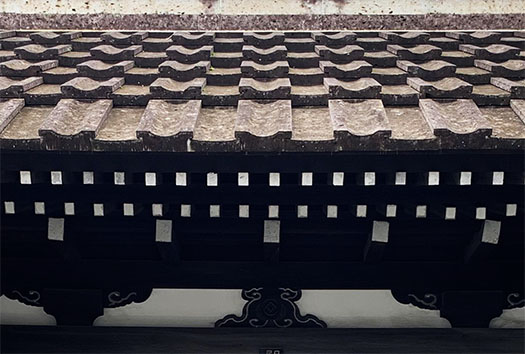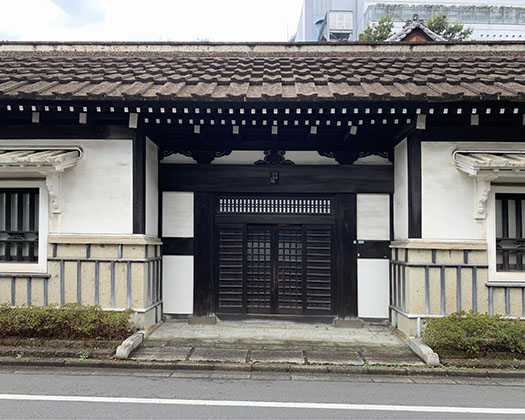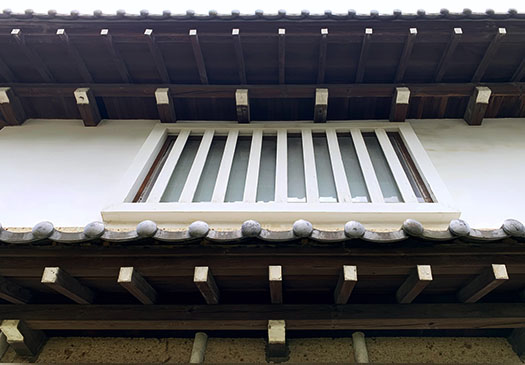


さて、民藝運動について考えて見ましたが、
いろいろな方向から見てやはり「民藝」概念特定の不在が決定的です。
創始者・柳宗悦氏には言語化できないまでも自ら創始した
「民藝」を日本文化の一分野として共有させるに足る統合的概念が
煮詰められた可能性があったのでしょうが、結果としては
共有不能な「直感」が選別基準であったことが決定的なのかと。
わたしが素朴に持った疑問「なぜ北海道には民藝が不在とされるのか?」
について、運動自体としてそれを解決できていないのではないか。
あくまでも運動創始者達の「直感」で触れられたものだけが「民藝」とされた。
たしかにこれでは北海道でかれらによってはさしたる民藝が発掘されず、
いわば空白区を必然化させてしまった。
移住主体の北海道人として共感はできても参加不能な運動のように思える。
写真は柳宗悦氏自邸の瓦屋根で、独特の瓦とその葺き方ですが、
北海道では開拓期から一貫して雪による屋根雪崩とともに瓦が
滑落してしまう現実があり、早々に瓦を放棄して鉄板屋根に移行した。
柳宗悦さんは「用の美」ということを訴えたが、
北海道ではそもそも瓦は「用」を満たしていなかったのだ。
こういう重要な点についての十分な考察を持たないまま、
創始者世代が不在になる中で、北海道への無視が固定化された。
一応確立された「民藝」文化の囲い込みと保守化。
北海道はすでに150年の開拓以降の歴史があり、
全国各地からの移民による混血が進み、そして伝統に変わって
近代的合理主義による日本民族生活の変容もまた進んだ。
民藝そのものが変革の対象になったともいえる。寒冷地生活実態に照応した
あたらな生活文化性を創造しつつあるし、すでに確立した住文化もある。
見てきたようなコンクリートブロック外断熱住宅などは一典型。
性能的合理性は日本民家の居住性能に革命をもたらしたに等しく、
そこで実現された性能レベルを木造でも実現することが目指されて
結果として「高断熱高気密」という民族的住宅技術資産を産み、
いま温暖地域でも急速に普及しつつある。
日本民藝館では民藝的風合いの建築として、組石造外観に着目して
大谷石が外皮面材として民藝の象徴とされたが、
一方北海道ではコンクリートブロックが2重に積まれる本格的組石造が
地域の「民藝」的な民族選択として実現してしまっている。
柳さんが死んで20年ほど経過してこういう大革新が北海道では生まれた。
もし「民藝」に統合概念が成立していれば、
こういった北海道での「暮らし革新」自体を民藝と呼ばない理由がない。
いやそれには使用感を含めた「歴史」熟成が必要だ、というのだろうか。
それでは国による「国宝」認定の基準のようだと思える。
それとも「美観的に・・・」ということか。
それでは創始者が指摘した「高級芸術」への批判のブーメランだと思う。
まさかそういう保守退嬰を創始者たちが望むとはとても思われない。
ことしも引き続き、毎日更新でブログを書き続けます。
始めたことは革新しつつ継続していくことが大切だと考えます。
English version⬇
[Absence of “Mingei” integrated concept Minge and Hokkaido-4]
Well, I thought about the Mingei movement,
From various directions, the absence of a specific concept of “folk art” is decisive.
The founder, Mr. Soetsu Yanagi, founded himself even if he could not verbalize it.
An integrated concept that is sufficient to share “folk art” as a field of Japanese culture
It may have been boiled down, but as a result
Is it decisive that “intuition” that cannot be shared was the selection criterion?
The simple question I had was “Why is there no folk art in Hokkaido?”
Isn’t it not possible to solve it as an exercise itself?
Only the ones touched by the “intuition” of the founders of the movement were regarded as “folk art”.
It is true that this did not excavate any folk art in Hokkaido.
So to speak, the blank area has become inevitable.
It seems to be a movement that I can sympathize with as a migrant-oriented Hokkaido person, but cannot participate.
The photo shows the tiled roof of Mr. Soetsu Yanagi’s house, which is a unique tile and how to roof it.
In Hokkaido, roof tiles have been consistently avalanche due to snow since the pioneering period.
There was a reality that it slipped down, so I quickly abandoned the tiles and switched to an iron plate roof.
Muneyoshi Yanagi complained that it was “beauty for use”,
In Hokkaido, roof tiles did not meet the “use” in the first place.
Without enough consideration of these important points
In the absence of the founder generation, the disregard for Hokkaido was fixed.
Enclosure and conservativeness of the established “folk art” culture.
Hokkaido already has a history of 150 years since its reclamation,
Mixed race by immigrants from all over the country, and changed to tradition
The transformation of Japanese national life by modern rationalism has also progressed.
It can be said that the folk art itself has become the target of change. Corresponding to the actual situation of living in cold regions
We are creating a new lifestyle and culture, and we have already established a living culture.
A typical example is a heat-insulated house outside a concrete block as you have seen.
Performance rationality is equivalent to revolutionizing the living performance of Japanese private houses,
The aim is to achieve the performance level achieved there even with wooden structures.
As a result, it produced a folk housing technology asset called “high heat insulation and high airtightness”.
It is rapidly becoming widespread even in warm regions.
At the Japan Folk Crafts Museum, we focused on the appearance of the kumite structure as an architecture with a folk art texture.
Oya stone was regarded as a symbol of folk art as an outer skin surface material,
On the other hand, in Hokkaido, there is a full-scale kumite structure where concrete blocks are piled up twice.
It has been realized as a “folk” ethnic choice in the region.
About 20 years after Mr. Yanagi died, such a big innovation was born in Hokkaido.
If the concept of integration is established in “folk art”,
There is no reason not to call this kind of “living innovation” in Hokkaido a folk art.
No, does that require “history” aging, including usability?
Then, it seems to be the standard of “national treasure” certification by the country.
Or is it “aesthetically …”?
Then, I think it is a boomerang of criticism of “luxury art” pointed out by the founder.
It seems unlikely that the founders would want such a conservative retreat.
I will continue to blog with daily updates.
I think it is important to continue to innovate what we have started.
Posted on 1月 1st, 2022 by 三木 奎吾
Filed under: 住宅マーケティング, 日本社会・文化研究







コメントを投稿
「※誹謗中傷や、悪意のある書き込み、営利目的などのコメントを防ぐために、投稿された全てのコメントは一時的に保留されますのでご了承ください。」
You must be logged in to post a comment.